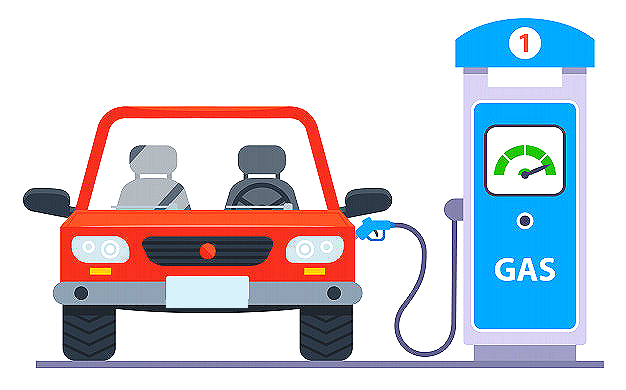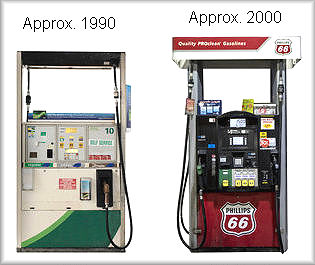



Mobile users:
For best results, view in Landscape mode.
In the 1980's, many cars still ran on
leaded gasoline, so filling stations offered
leaded and unleaded pumps to give
customers the right fuel for their engine.
In the mid - 1980's, credit card readers were integrated into
pump dispensers.
In 1986, E-Z Serve and its subsidiary Auto-gas introduce
the first pay-at-the-pump credit card solution, paving the way
for 24-hour self-service.
Pay at the pump is a system used at gas (filling) stations
where customers can pay for their fuel by inserting a
credit or debit card or fuel card into a slot on the pump,
bypassing the requirement to make the transaction with the station
attendant or to walk away from your vehicle.
Pay at the pump is seen as a way to keep the cost of gasoline down by
reducing the need for employees at gas stations.
Be careful when paying at the pump:
Those who use the pay at the pump feature could be putting
themselves at risk for fraud, as thieves attach skimmers
to the pumps that can steal the information
off the cards used to make purchases.
Many debit cards can be used to make the purchase either as
debit or credit.
But those who make the purchases as debit are potentially feeding
their information into the skimmers.
Without the human interaction, there is no verification system
when credit cards are used to make purchases, and
no signature is required.
This enables those in possession of stolen or cloned credit cards,
or those who are otherwise making unauthorized use of someone's
card to purchase gasoline without a signature.
By 1994, only 13 percent of stations had the technology,
but 80 percent of stations used the technology by 2002,
and virtually all U.S. stations do today.

Did you know how a gas pump knows when your tank is full?
It's because of a tube that runs back up into the fuel pump handle.
As gas flows through the nozzle, a vacuum pressure causes
air to be sucked up.
Once the tank is full, the flow of air stops and the vacuum pressure
begins to build.
In the nozzle handle the pressure builds until it forces a lever that
pops the handle trigger, shutting off the flow of gasoline.
Most modern pumps have an automatic cut-off feature that
stops the flow when the tank is full.
This is done with an auxiliary sensing tube running from just
inside the mouth of the nozzle to a Venturi pump in
the pump handle.
A mechanical valve in the pump handle detects a change of pressure
and closes, preventing the flow of fuel.
The average price of gas in the U.S. per year:
In 1920, the average price was $0.20 gal.
In 1930, the average price was $0.20 gal.
In 1940, the average price was $0.18 gal.
In 1950, the average price was $0.27 gal.
In 1960, the average price was $0.31 gal.
In 1970, the average price was $0.36 gal.
The OPEC oil embargo began in
October 1973 and ended March 1974.
In 1974, the average price of gas in the U.S. was $0.53.
This was equivalent to $2.95 in 2020 dollars.
In 1980, the average price was $1.19 gal.
In 1990, the average price was $1.15 gal.
In 2000, the average price was $1.51 gal.